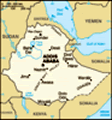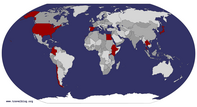Advertisement
Published: August 24th 2010
Riding the Blue Donkey:
Saturday is culture day. This entails venturing forth into the chaos of the city. Needless to say, hunting culture is tiring work. Well caffeinated to face the day, we walked to Bole Road to catch a blue donkey. Blue donkeys are blue and white Toyota mini-buses with three rows of seats in the back. Though their final destination is often mysterious, they are the most cost efficient form of public transportation. As they weave through traffic deftly avoiding pot holes, people, and goats, the money-taker leans out the window of the sliding door braying to the wind the intended destinations. At the sign of a raised hand or eyebrow, the donkey skreeches to a stop, the door rattles open, and you climb into the multi-eyed belly of the beast. The ten others passengers within find the sight of big gallumpy white ferengis absolutely riveting. As the destinations are still mostly incomprehensible, getting in the blue donkey is often an act of faith. Faith, however, also creates other complications. Although hog tied goats or the occasional chicken are not problematic, neighbor Nick’s attempt to bring Mino the dog into the donkey rarely goes smoothly. Apparently back in
the days of wonder, the Prophet Mohammed buried some milk so he could dazzle the true believers with a smite-the-ground-with-the-staff-bring-forth-milk miracle. Unfortunately, a dog came along and dug up the goat skin of milk before the Prophet could demonstrate his ‘God favors me so you should listen’ power. Consequently, Muslims don’t like dogs. In a country with a healthy population of Muslims, there is a very good chance that the driver or the passengers won’t be happy with a dog in their blue donkey. Luckily, the Ethiopian Orthodox don’t have such qualms if the dog is a paying customer.
Saturday at noon, Bole Road is choked with donkeys. Eventually, one swerves recklessly across two lanes, lurches to a stop, and herds us in. It is immediately clear that until we reach Mesqel Square, a beautifully orchestrated but unacknowledged battle will be waged for the contents of my pockets. First, the separation: I sit in front, carly is pushed to the back. Next, the distraction: suddenly very eager to share their culture, carly’s neighbors struggle to beguile her with riveting cell phone video of an orthodox church service. Then the approach: though clearly there is no space, a ‘passenger’ squeezes
onto the front bench next to me; fortuitously pressing me into the hand sitting innocently to my left. Proximity achieved, the hand comes alive, wiggling, squirming, and trying desperately to worm its way into my pocket. Meanwhile, the hand’s owner sits rocking naturally to the waves of the road and gazing dully out the window. Stabbing the hand with a pen would be presumptuous, so I also wiggle and squirm to frustrate the questing hand. Finally, the denouement: spontaneously, all the coins leap from the money-taker’s hand and spill around my feet. The hand, pressing and probing, waits expectantly for the pocket of its desire to open welcomingly as I lean down to helpfully collect the riches. Alas, I do not play my part and instead jam my hands in my pockets and lift my feet. Such crass behavior apparently convinces them that despite the simple elegance of this well-rehearsed drama, I am unwilling to part with my belongings. After a brief discussion, the blue donkey whips around, and the money-taker regretfully informs us that traffic ahead is impassable and impossible. They simply cannot proceed. Smiling, he returns our 2 birr fare, and they speed back up Bole, presumably trolling
for more agreeable ferengis. We walk the last couple of blocks, where, shockingly, traffic appears to be flowing normally into and out of the square.
We cross the street to the new “Red Terror” museum, sitting where Bole Bole Road spills into the concrete sea of Mesqel Square. Fresh from the blue donkey drama, I assume nothing will restore my faith in people like a quick commemoration of a government purge that killed tens of thousands.
The Ugly History:
After serving as regent for 14 years, on November 2, 1930 Prince Ras Tafari was humbly crowned “His Imperial Majesty Haile Selassie I, King of Kings, Conquering Lion of the Tribe of Judah, and the Elect of God”. For the next 40 years, he nurtured the cult of sycophantic emperor worship, doing some things tolerably well and others not so well. In the early 70s, the monarchy began to crumble as discontent grew over rural feudalism, corruption, inequality, and the snail’s pace of modernization. Then in 1973, in the midst of the internationally debilitating oil crises, God himself abandoned the Emperor. In the north, when the rains did not come, famine did. An estimated 200,000 died between 1972-74.
The initial government response was denial, and then appallingly inadequate. The famine proved to be the straw that broke the Lion of Judah’s back. While professing undying loyalty, the military slowly undermined the foundations of monarchy, and on Sept 12th, 1974, Haile Selassie was deposed.
The Coordinating Committee of the Armed Forces, known in Amharic as the Derg, quickly got over any pretenses of loyalty to the emperor, most notably when they killed him. Having disposed of the Elect of God, the purge began in earnest. Generals, politicians, aristocrats of the old regime, and the royal family were first against the wall. Soon after, the Derg issued its declaration of socialism, nationalized rural and urban land and switched sides; instead of getting guns and grain from the US, the Derg, led by Major Mengistu, went into business with the USSR: another military dictatorship dressed up in Lenin-Marxist rhetoric; another pawn in the 20th century’s Great Game.
For those of you paying attention at home, the Chile pawn was put into play at about the exact same time (Allende assassinated Sept. 11, 1973); except in Santiago, the threat of international communism and the CIA was used to bring down
the oldest democracy in South America. Disappearing the opposition was a common thread for the two military dictatorships, but the Derg had a bigger population to work with and no apparent interest in feigning secrecy.
Following the shining example of their predecessors (Soviet Russia had their own Red Terror in the early 20th century), the Revolution started cannibalizing its own ranks. The predictable struggle for absolute power dressed up in the raiments of ideological purity eventually unleashed the Derg’s “Red Terror”: the ‘revolutionary guards of the proletariat’ engaged in the serious business of class warfare, spiced up with torture centers, random executions and mass graves. Serious about eliminating the opposition, the dead literally piled up on the street corners in 12 months of government sponsored terror. Those that made it to the morgue could be claimed by their families after paying the ‘bullet fee’.
A few years later, the Derg spectacularly demonstrated that not only were they waaay better at killing than the emperor, they were more worthless and more callous in the face of mass famine. War and Death had seized power with the Derg. In 1983-84, Pestilence and Famine set forth, and the four rode rampant
across the northern highlands. This time up to a million would die in the famine. Meanwhile in Addis, the Derg busily prepared for the parade to celebrate the stunning ten-year success of scientific socialism.
Eventually, an alphabet soup of armed opposition groups coalesced to get rid of the Derg. On May 21st, 1991 Mengistu fled to Zimbabwe. A week later, the EPRDF, led by Meles Zenawi, marched into Addis. Soon after, Meles became president of the ‘democratic’ republic of Ethiopia. Not surprisingly, twenty years later, the “democratically elected” president is still Meles.
The Red Terror Memorial Museum:
The cynical might presume that the museum is a gentle governmental reminder that though democracy in Ethiopia is a charade, life used to be a lot less pleasant. In grainy black and white photographs, the story unfolds: Haile Selassie doing regal things; people bowing and scraping in the dirt at his passing motorcade; then horrific skeletal scarecrows, the human face of famine. Demonstrations. Strikes. The Emperor being escorted from the palace. This gives way to the opening foray of the people’s glorious Revolution, where presumably, hope in a new day still flowered. Then ominously a picture of Mengistu hurling a
clear bottle filled with red liquid. As the bottle smashed to the ground, Mengitsu declared, “Death to the counter-revolutionaries!” The Red Terror was officially on. In the museum, things get decidedly heavier. Sometimes symbolically; sometimes graphically: a diorama of the preferred way to hog tie a person for effective ‘enhanced interrogation’. Tools of the trade. A wall covered with black and white photos, like a page out of a year book. Some blacked out with tape, all presumably dead. In a small room off to the side, a memorial to the missing. An unmarked grave, a pile of dirt with a few faded plants and the vista of mountains stretching out into the blue cloudless sky. Not so moving until turning around to leave, a hundred eyeless sockets stare at you from a floor-to-ceiling glass case filled with skulls. Ok, that’s effective. Piling on the heavy now. Blood red canvases of people being tortured and killed. A couple of bloody hacked off mannequin feet in the corner. Coffins filled with the dirty shoes and scraps of clothes excavated from a mass grave. Another room filled with flag draped coffins. Finally, the end: the liberating army of Meles, and the photos
of the Derg on trial, convicted of genocide. A happy-ish ending except that Mengitsu is still sipping Pina Coladas in Zimbabwe with Robert Mugabe, another particularly unpleasant character.
Like reading about it, the museum was decidedly un-fun. It may very well be just state sponsored propaganda as well. Over dinner one evening, an Ethiopian lamented, “In every family, someone killed, and someone was killed. We need to bury the past not use it to justify the present.” Cheery options when the past was a nightmare and the present is a lie.
After our uplifting review of the making of modern Ethiopia, we decided we needed a little Ethiopian culture that whether under monarchy, scientific socialism, or a dictatorship masquerading as ‘democracy’, has always been excellent: coffee. One scourge Ethiopia has thankfully avoided is NesCrape.
Advertisement
Tot: 0.212s; Tpl: 0.015s; cc: 9; qc: 71; dbt: 0.1111s; 1; m:domysql w:travelblog (10.17.0.13); sld: 1;
; mem: 1.3mb













paula
non-member comment
After reading it today I wonder if you are missing Transantiago! Sounds like a limo compare to your blue donkey. Congratulations! I have enjoyed reading it very much and also have learnt some Ethopian history Regards